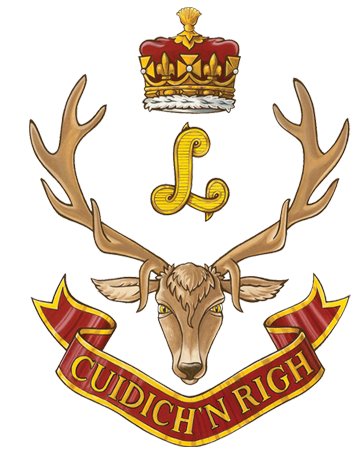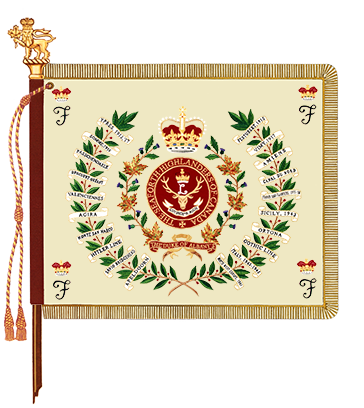The Seaforth Highlanders of Canada
The official lineage of The Seaforth Highlanders of Canada infantry regiment.

Colonel-in-Chief: Vacant
Badge
Description
A stag's head caboshed proper the antlers encircling a Letter "L" Or ensigned by the coronet of a younger son of the Sovereign proper all above a scroll Gules edged and inscribed CUIDICH'N RIGH in letters Or.
Symbolism
The badge is modelled on that of the Seaforth Highlanders of the British Army. The cypher is that of Leopold, Duke of Albany (1853-1884), fourth son of Queen Victoria, ensigned by his coronet.
Motto
CUIDICH'N RIGH (Help the King)
March
"The Piobaireachd of Donald Dhu"
Alliance
British Army
The Royal Regiment of Scotland
Regimental colour

Camp flag

Battle honours
The First World War
YPRES, 1915, '17; FESTUBERT, 1915; SOMME, 1916; Ancre Heights; Ancre, 1916; ARRAS, 1917, '18; Vimy, 1917; Passchendaele; AMIENS; Scarpe, 1918; Drocourt-Quéant; HINDENBURG LINE; Canal du Nord; VALENCIENNES; SAMBRE; FRANCE AND FLANDERS, 1915-18.
The Second World War
LANDING IN SICILY; Agira; ADRANO; Troina Valley; SICILY, 1943; Monte San Marco; Baranello; The Moro; San Leonardo; The Gully; Ortona; LIRI VALLEY; Hitler Line; GOTHIC LINE; Pozzo Alto Ridge; RIMINI LINE; San Martino-San Lorenzo; San Fortunato; Savio Bridgehead; Naviglio Canal; Fosso Munio; Granarolo; ITALY, 1943-1945; Apeldoorn; NORTH-WEST EUROPE, 1945.
South-West Asia
AFGHANISTAN
Lineage
This Reserve Force regiment originated in Vancouver, British Columbia on 24 November 1910, when the '72nd Highlanders of Canada' was authorized to be formed.Footnote 1 It was redesignated: '72nd Seaforth Highlanders of Canada' on 15 April 1912;Footnote 2 '72nd Regiment "Seaforth Highlanders of Canada"' on 16 December 1912;Footnote 3 'The Seaforth Highlanders of Canada' on 12 March 1920;Footnote 4 '2nd Battalion, The Seaforth Highlanders of Canada' on 7 November 1940;Footnote 5 and 'The Seaforth Highlanders of Canada' on 1 November 1945.Footnote 6
Notes:
Upon redesignation as The Seaforth Highlanders of Canada on 12 March 1920 (see above), it was organized as a two battalion regiment with the 1st Battalion (72nd Battalion, CEF) on the Non Permanent Active Militia order of battle and a 2nd Battalion (231st Battalion, CEF) on the Reserve order of battle. The reserve unit was disbanded on 14 December 1936 (GO 3/37).
The Seaforth Highlanders of Canada were disbanded for the purpose of reorganization on 15 September 1920 and reorganized the same day (GO 232/20). This change was administrative and does not affect the lineage of the regiment.
On 4 May 1951, the regiment mobilized two temporary Active Force companies designated "E" and "F" Company (CAO 110-2, Pt 'B', Supp Issue No. 245/51; and SD 1 Letter No. 4237, 5 May 1951). "E" Company was reduced to nil strength upon its personnel being incorporated into the '1st Canadian Highland Battalion' for service in Germany with the North Atlantic Treaty Organization (SD 1 Letter No. 4365, 12 November 1951). It was disbanded on 29 July 1953 ( CAO 78-2, Pt 'B', Supp Issue No. 352/53). "F" Company was initially used as a reinforcement pool for "E" Company. On 15 May 1952, it was reduced to nil strength, upon its personnel being absorbed by the newly formed '2nd Canadian Highland Battalion' for service in Korea with the United Nations (SD 1 Letter No. 4452, 22 April 1952; and CAO 110-2, Pt 'B', Supp Issue No. 283/52). "F" Company was disbanded on 29 July 1953 (CAO 78-2, Pt 'B', Supp Issue No. 352/53).
Perpetuations
'72nd' and '231st "Overseas" Battalion, CEF'
Headquarters Location
Vancouver, British Columbia
Operational history
The First World War
The 72nd Battalion, which was authorized on 10 July 1915 as the '72nd "Overseas" Battalion, CEF',Footnote 7 embarked for Britain on 23 April 1916.Footnote 8 It disembarked in France on 13 August 1916, where it fought as part of the 12th Infantry Brigade, 4th Canadian Division in France and Flanders until the end of the war.Footnote 9 The battalion was disbanded on 30 August 1920.Footnote 10
The 231st Battalion, which was authorized on 15 July 1916 as the '231st "Overseas" Battalion, CEF',Footnote 11 embarked for Britain on 11 April 1917.Footnote 12 On 22 April 1917, its personnel were absorbed by the '24th Reserve Battalion, CEF' to provide reinforcements for the Canadian Corps in the field.Footnote 13 The battalion was disbanded on 11 April 1918.Footnote 14
The Second World War
The regiment mobilized 'The Seaforth Highlanders of Canada, CASF' for active service on 1 September 1939.Footnote 15 It was redesignated '1st Battalion, The Seaforth Highlanders of Canada, CASF' on 7 November 1940.Footnote 16 It embarked for Britain on 20 December 1939.Footnote 17 The battalion landed in Sicily on 10 July 1943 and in Italy on 4 September 1943 as part of the 2nd Brigade, 1st Canadian Infantry Division.Footnote 18 On 14 March 1945, it moved with the 1st Canadian Corps to North-West Europe, where it fought until the end of the war.Footnote 19 The overseas battalion was disbanded on 31 October 1945.Footnote 20
On 1 June 1945, a second Active Force component of the regiment was mobilized for service in the Pacific theatre of operations, under the designation '2nd Canadian Infantry Battalion (The Seaforth Highlanders of Canada), CASF'.Footnote 21 The battalion was disbanded on 1 November 1945.Footnote 22
South-West Asia
From 2002 to 2014, the Seaforth Highlanders of Canada reinforced various CAF units deployed to Afghanistan.Footnote 23
Page details
- Date modified: